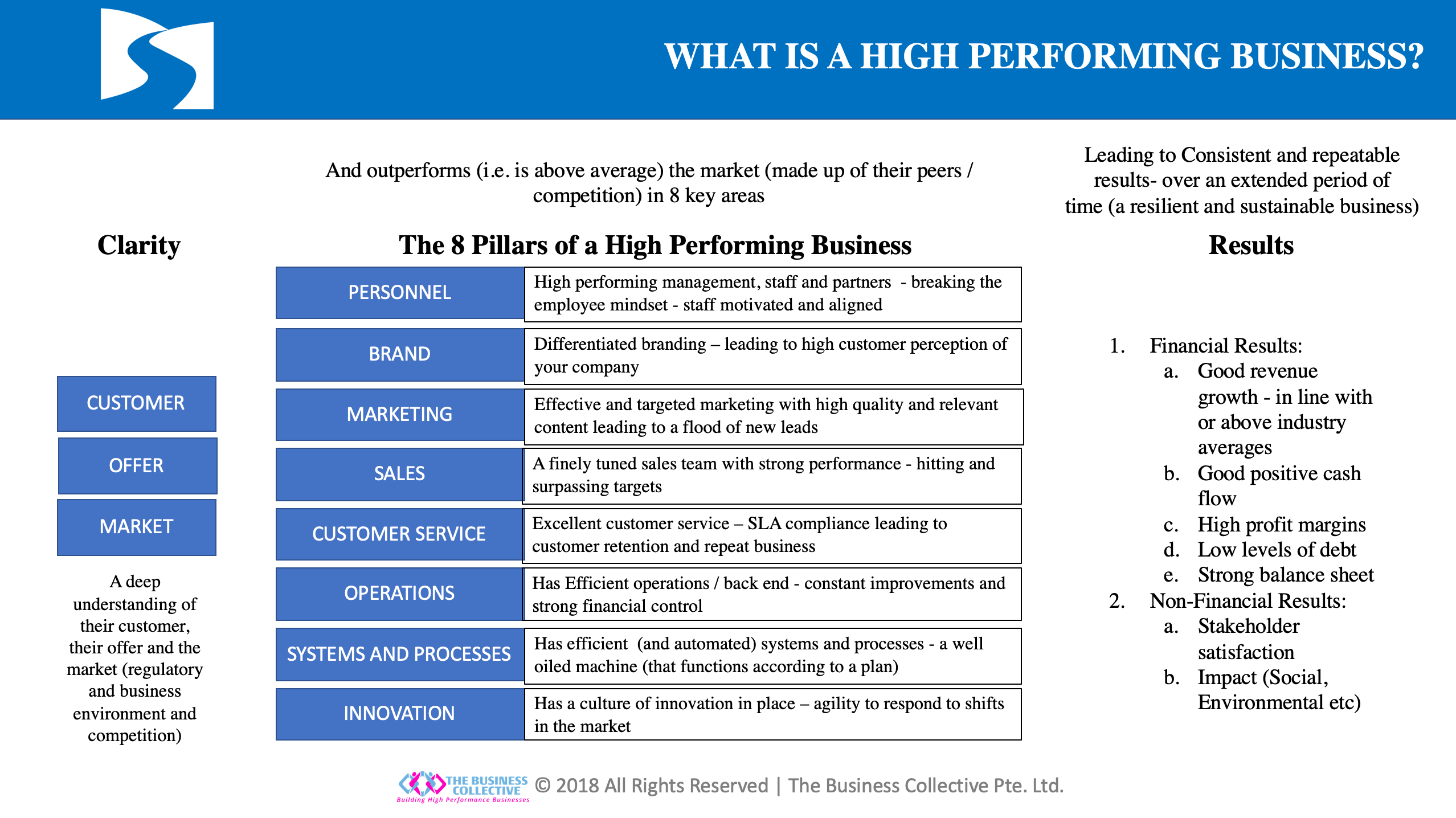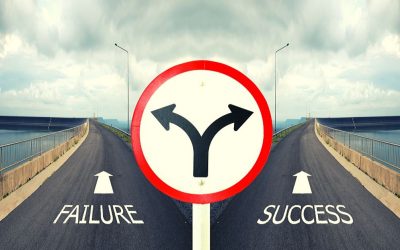The dream of every business owner or entrepreneur is to build a successful business. But what is success for you as a business owner? At The Business Collective we define success as becoming a High Performing Business. Naturally you are asking what does that mean. In this post I will tell you what we define a High Performing Business to be.
Too often I have spoken to entrepreneurs who have misguided ideas as to what business success means. Some believe it’s their valuation, others revenue and yet others believe that it’s profit that determines success. This vision of success defines your short and midterm business strategy and can often lead to you focusing on the wrong metrics and adopting the wrong strategy that ultimately leads to business failure.
You will hear me talking a lot about Clarity, Focus and Action as the formula for success and it all starts with gaining Clarity on what a successful business looks like. With this clarity, you already know where your focus should be and I will then show you the steps you can take to turn this clarity into a single-minded focus and then action that turns into results. And fear not, you are not alone in this endeavor, we have built a community that helps entrepreneurs like you to gain this necessary clarity (email us at enquiry@thebusinesscollective.sg for more details).
We are The Business Collective, a venture creation firm based in Singapore that specializes in building High Performing Businesses.
‘A High Performing Business is a business that has a deep understanding of its Customer, its Offer and the Market within which it operates, and outperforms the market in 8 key areas, leading to consistent and repeatable results over an extended period of time’
Simply put, a High Performing Business is a business that has a deep understanding of 3 things:
1. Who they serve — The Customer
2. What their value to the customer is — The Offer
3. The business environment they operate in — The Market — which includes the general business environment, the competition and the regulatory environment
I will use one of our portfolio companies to illustrate this. We have a business that deals with firefighting equipment (Mr Fire X). Our core product was designed with the customer’s needs in mind. In this case it was a domestic use fire extinguisher. The Customer is typically a male with a family home who needs something to protect his family that is easy to use and maintenance free. We had to create an offer that gave him a lot of perceived value so we bundled the product with some training material and advice on how to protect his home from fire, and third-party products that complemented the extinguisher like a smoke alarm and blanket (The Offer). We also had to have a good understanding of competitive products and what our value proposition was against them; in this case it boiled down to free maintenance, ease of use and the low toxicity of the product. We then looked at the regulatory environment and how that affected the messaging in our marketing of the product and we realized that we needed to focus in the initial stages a lot on doing general awareness events/campaigns to help people understand the need for fire safety at home and show them what their options were. We also realized that the product was a premium product so the markets we sold the product in had to be relatively mature and that delivery of the product was difficult in small quantities; so while we focused on eCommerce as the primary marketing channel, we had to let local retailers and local eCommerce players stock the product (The Market).
As you can see, a deep understanding of these 3 subjects (Customer, Offer and Market) can determine a winning strategy for a product or service. Once you have this information you can move to the next part which involves your delivery of the product or service.
A High Performing Business outperforms (i.e. is above average) the market (made up of their peers/competition) in 8 key areas (The 8 Pillars of a High Performing Business):
1. Personnel: Has high performing personnel — management, staff and partners — without the employee mindset (all personnel are motivated and aligned to the mission, vision and strategy). This translates to an organization with the following attributes:
a. A lean structure
b. Focused job responsibilities for all personnel
c. Everyone is a Profit Center (as far as possible)
d. Everyone is aligned to the true north of the company
2. Brand: A good brand has the following:
a. It is recognized in the market as a leader (in a focused area or niche) — the company generally does things well in their chosen area and is rewarded financially for this — at a level that is above the average for your industry
b. It is unique — the company and brand is memorable and makes an impression on all who come across it
c. People who passionately defend the brand — or promote your brand because they believe in it and it’s a good product/service (see Footnote 1) and has impact on the community it serves
d. The Brand is recognizable and well known (The intended audience knows what you stand for) and has high exposure in the desired market segment
e. There is Consistency across all touch points with the customer. It is not erratic and stands for something predetermined that is valued by the customer.
3. Marketing: Effective marketing means effective customer engagement that results in:
a. The constant and consistent generation of new leads with a low cost of acquisition of these leads
b. A good clean segmented and engaged database
c. High ROME (Return on Marketing Effort) (see Footnote 2)
d. High impact campaigns
4. Sales: Strong sales performance implies consistently hitting and surpassing sales targets achieved through:
a. A strong feedback loop
b. Robust processes that ensure adequate follow up on sales activities and good pipeline management
5. Customer Service: Excellent customer service results in high customer satisfaction, customer retention and repeat business
6. Operations: Efficient operations, fulfillment and other back end processes require monitoring of the right metrics, implementation of constant improvements and quality control, and strong financial control
7. Systems and Processes: Automated and efficient systems and processes in all back and front end systems produce a well-oiled machine (that functions according to a plan)
a. Constant review and improvement of processes
b. Capitalizing on technology to drive improvement (internal) and connect to customers (external)
8. Innovation: A strong culture of innovation in place will give the company the required agility to respond to shifts in the market. This is achieved by:
a. A culture of experimentation in all areas
b. Horizon thinking
c. A measured appetite for risk
All this leads to Consistent and Repeatable results[see Footnote 3]– over an extended period of time [see Footnote 4], the ultimate definition of a resilient and sustainable business. Results which are both financial and non-financial:
1. Financial Results:
a. Good revenue growth — in line with or above industry averages
b. Good positive cash flow
c. High profit margins
d. Low levels of debt
e. A strong balance sheet
2. Non-Financial Results[see Footnote 5]:
a. High Stakeholder satisfaction [see Footnote 6]
b. Impact (Social and Environmental)
As you can see with this definition of a high performing business I have avoided the issue of high valuation and instead have focused on what really matters to a business; profitability and cash flow. This is realistic and achievable and removes the focus from fundraising at every stage of a business. Instead, we at The Business Collective focus on building a solid foundation and making the business profitable as quickly as possible. At different stages of a business’ evolution, the focus will change but this is the true north of every business and it should be the objective of every business owner. A high valuation will be a natural consequence of this focus on profitability (we discuss what investors look for when valuing companies in the final stage of The High Performing Business Roadmap).
With this clarity on what a business should be, we can shift to plotting a path towards getting there and this is achieved by focusing on what really matters to the organization at each stage of its evolution in a highly disciplined manner. We have developed a 9 Step Process that all our businesses follow, a roadmap that will make them all high performing businesses in a short period of time[see Footnote 7] without the uncertainty (by following a clear and well-defined path) and information overload (one all-encompassing system) and loneliness that comes with entrepreneurship (being part of an active and supportive community).
Stay tuned for our next blog post where we will go into laying out the Three Stages of building a High Performing Business for you and get you on that path to building your very own.
Like what you read? Get informed when we publish the latest strategies before the competition. Join our mailing list by sending us an email to enquiry@thebusinesscollective.sg.
Footnotes:
[1] Note that what you need is a superior Brand and not a superior product. This is counterintuitive but many companies do not have superior products but just good branding. It helps to have a great product but is not a precondition to having a high performing business. What you need is a product that matches your customers’ requirements/needs. It’s not a lousy product but not necessarily superior.
[2] ROME includes Return on Ad Spend (ROAS) and other marketing efforts that incur some cost
[3] Financial results are relative but imply high margins and positive cash flow more than year on year aggressive growth
[4] The time frame of high performance is important as it removes the luck factor. The period of time can vary depending on individual circumstances and industry life cycle but in general over the course of a full year at the very least
[5] Non-financial results are almost just as important to small businesses.
[6] We use the term Stakeholder satisfaction in place of Employee Satisfaction as in our structure we don’t have employees, everyone is a partner and has a vested interest in the success of the business. We are trying to break the employee mindset. The level of performance is measured in the satisfaction of all Stakeholders, including our customers, partners and shareholders.
[7] Time is relative but by following our process your learning is accelerated when compared to trying to figure this out yourself. You can cut down the time by up to 90%





0 Comments